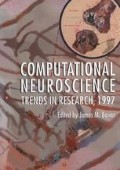Abstract
The experimental studies show that NO can both enhance glutamate release from the presynapse and inhibit Ca++ influx in the postsynapse. In this paper, a theoretical model is presented to study these roles of NO in synaptic potentiation. In the model, NO is assumed to be produced in the postsynapse and diffuse into the extracellular space and then to the presynapse. Two kinds of excitatory receptor channels, NMDA and non-NMDA channels, are considered in the postsynaptic membrane. NO mediated glutamate release in the presynapse is expressed as the increase of the open channels in the postsynapse, and NO also decreases NMDA current since NMDA channel modulates Ca++ influx. Our simulations show that at low concentration of NO (0.5 uM), NO depresses the synaptic potentiation when a tetanus stimulation is delivered, but at high concentration ( l0uM), NO facilitates the synaptic potentiation. The membrane permeability, and the diffusion coefficient of NO are significant factors in determining the integrated function of NO in synaptic potentiation because they determine the concentration difference between the pre-and postsynaptic cells. Although accurate experimental measurements of all these parameters are not available, the model presented predicts that only at relatively high NO concentration levels, does NO facilitate production of LTP.
Access this chapter
Tax calculation will be finalised at checkout
Purchases are for personal use only
Preview
Unable to display preview. Download preview PDF.
References
Palmer RMJ, Ferrige AG, et al., Nitric oxide release accounts for the biological activity of endothelium-derived relaxing factor, Nature 327: 524 - 526, 1987
Moncada S, The L-arginine: nitric oxide pathway Acta Physiol. Scand. 145: 201 - 227. 1992
Schuman EM, Madison DV Nitric oxide and synaptic function, Annu. Rev. Neurosci. 17: 153 - 83, 1994
Garthwaite J. Charles, SL Chess-Williams R, Endothelium-derived relaxing factor release on activation of NMDA receptors suggests role as intracellular messenger in the brain, Nature 336: 385 - 88, 1988.
Southam E and Garthwaite J, Comparative effects of some nitric oxide donors on cyclic GMP levels in rat cerebcllarr slices, Neurosci. Letters 130: 107 - 11, 1991
Lonart G, Wong J and Johnson KM, Nitric oxide induces neurotransmitter release from hippocampal slices, European. J. of Pharmacology 22: 271 - 3, 1992
Lawrence AJ and Jarrott B, Nitric oxide increases interstitial excitatory amino acid release in the rat dorsomedial medulla oblongata, Neuro.sci. Letters 151:126-129 1993
Meffert MK, Premack BA and Schulman H Nitric oxide stimulates Ca2+ - independent synaptic vesicle release, Neuron 12: 1235 - 44, 1994
Hoyt KR, Tang LH, et al. Nitric oxide modulates NMDA-induced increases in intracellular Ca++ in cultured rat forebrain neurons. Brain Res. 592: 310 - 6, 1992.
Tanaka T. Endogenous nitric oxide inhibits NMDA- and kainates-responses by a negative feedback system in rat hippocampal neurons. Brain Res. 631: 72 - 6. 1993
Meulemans A, Diffusion coefficients and half-lives of nitric oxide and N-nitroso-L-arginine in rat cortex Nearnsci. Letters 171: 89 - 93, 1994
Kitajima T and Hara K, A model of mechanisms of long-term potentiation in the hippocampus. Biol. Cyhern.64:33=9,1990
Bliss TVP and Collingridgc GL, A synaptic model of memory: Long-term potentiation in the hippocampus, Nature 361: 31 - 9, 1993
Kelm M, Feelisch M, et al., Quantitative and kinetic characterization of nitric oxide and EDRF released from culture endothelial cells, Biochem. Biophvs. Res. Commun. 154: 236 - 44, 1988
Vanderkooi JM, Wright WW, et al., Nitric oxide diffusion coefficients in solutions, proteins and membranes determined by phosphorescence, Biochimica et Biophysica Acta, 1207: 249 - 54, 1994.
Author information
Authors and Affiliations
Editor information
Editors and Affiliations
Rights and permissions
Copyright information
© 1997 Springer Science+Business Media New York
About this chapter
Cite this chapter
Wang, T., Thakor, N.V. (1997). A Model of the Possible Role of Gaseous Neuromessenger Nitric Oxide in Synaptic Potentiation. In: Bower, J.M. (eds) Computational Neuroscience. Springer, Boston, MA. https://doi.org/10.1007/978-1-4757-9800-5_6
Download citation
DOI: https://doi.org/10.1007/978-1-4757-9800-5_6
Publisher Name: Springer, Boston, MA
Print ISBN: 978-1-4757-9802-9
Online ISBN: 978-1-4757-9800-5
eBook Packages: Springer Book Archive

